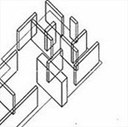0187 Mies van der Rohes visueller ‚Kalkül’ der Erneuerung
Architektonischer Wandel im Anschluss an Berlages Umformungstheorem
Identifiers (Article)
Identifiers (Files)
Abstract
This essay represents a pioneering attempt to conceive of Mies van der Rohe's work as a transformation of ‘archetypes’. We will begin by addressing Mies' belief in architectural objectivity, which rests on three theoretic positions: first, the antispeculative reference to scientific practice of Alois Riehl's philosophy; secondly, the ‘objective philosophy’ of the biologist Raoul H. Francé, which requires that any effective action follows the “laws of the renewal of the organic world”; and finally, the demand for architectural renewal through the transformation of archetypal forms made by Hendrik Petrus Berlage following Gottfried Semper. It is notably Mies' reference to Berlage's theorem that will be explored in the second part of this essay that will shed new light onto his design practice. At the core of the analysis an array of specific designs by Frank Lloyd Wright provides the framework for a fundamental understanding of Mies's early country house designs as resting on the process of modernization of archetypes; these were embodied in Japanese interiors, reproductions of which were widely disseminated in Germany in the 1920s, as well as in the then re-discovered work of Schinkel's disciple Ludwig Persius. The aim of this study of renewal through transformation is not only to reveal Mies' design process as a matter of complex visual ‘calculus’, but also to make a general contribution to the semantics of modernity.
Statistics


License

This work is licensed under a Creative Commons Attribution-NonCommercial-NoDerivatives 4.0 International License.



